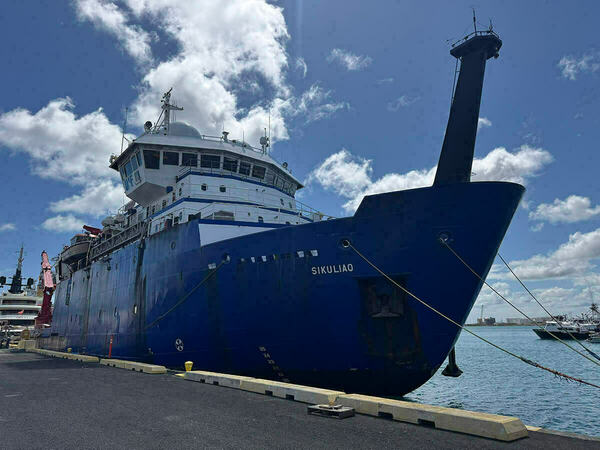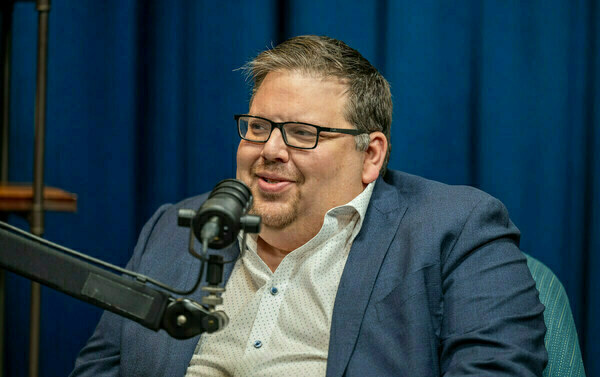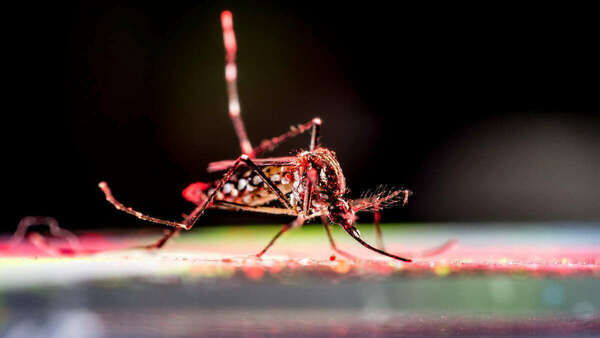Cyberinfrastructure at sea: Computing, and community, on the edge
Two members of the U.S. National Science Foundation (NSF) CI Compass learned what computing “at the edge” can look like during the spring 2025 semester.
Raymond James Gallant, NSF CI Compass Fellow 2024 and undergraduate student at Eastern New Mexico University, and Mahedi Hasan, research assistant for NSF CI Compass and at the Innovation Diffusion Lab at Texas Tech University, joined the crew of the Research Vessel (RV) Sikuliaq as it traveled across Pacific waters from Hawaii to Alaska. Together, they worked with the ship’s crew and other participants aboard to learn about cyberinfrastructure (CI) and how the scientific community functions in this unique environment.
The RV Sikuliaq (pronounced see-koo-lee-auk) is 261 feet long, and brings students, scientists, and researchers through the icy waters around Alaska throughout the year, launching from Seward, Alaska. The vessel is owned by the NSF and operated by the University of Alaska Fairbanks (UAF) College of Fisheries and Ocean Sciences (CFOS). The vessel, with its ice-strengthened hull is equipped with sonars for seafloor mapping, fisheries, current-profiling, and oceanographic winches, as well as overboarding frames and cranes for lowering instruments into the ocean. The ship includes multiple spaces to work and collect data, including an analytical lab, electronics computer lab, wet lab, and a main lab on board equipped with fume hoods and work benches.
“Sikuliaq feels like its own world. It has its own routines, its own systems, and its own community,” said Hasan. “From the bridge to the engine room, lab spaces to the mess hall, everything is designed to support research and life at sea. Now I understand why this vessel is known as a flagship in the U.S. Academic Research Fleet (ARF). It truly is a remarkable place, both technically and socially.”
For Gallant, the voyage changed how he viewed CI in general.
“The experience gave me a deeper respect for the operational side of CI. Today, I see its critical role in enabling secure, real-time scientific discovery in remote environments,” said Gallant. “It also opened my eyes to career paths that combine technical security work with field science.”
Showcasing CI career path opportunities is a cornerstone of the NSF CI Compass Student Fellowship Program (CICF). Throughout the CICF Spring Program, fellows learn CI-related skills that are important to the work of NSF Major and Mid-scale facilities (MFs). Guest speakers join the curriculum to speak about the CI needs of their laboratories and facilities. The program hosted Julian Race, IT manager for the RV Sikuliaq, and Chris Romsos, datapresence systems engineer, Regional Class Research Vessel (RCRV) in the 2025 program. NSF CI Compass members engaged with the RV Taani in 2022 and 2023 to help the scientists and CI professionals onboard to minimize the time between data capture and data analysis. Thus, reducing the time to science.
“The CICF program is designed to introduce students to real-world CI challenges and give them the tools to begin solving them. The program also introduces students to guest speakers from MFs supporting scientific discoveries, ” said Angela Murillo, director of the CICF program and co-principal investigator (Co-PI) of NSF CI Compass. “Being able to connect students to experiences like Mahedi and Raymond had on the RV Sikuliaq lets them see what careers in CI can actually look like.”

Collaborating with partners in the NSF Major- and Mid-scale facilities further opens doors for both the center and CICF students.
“We are excited to work with the U.S. ARF vessels to learn more about the unique CI challenges scientists and engineers face in gathering data, keeping it secure, and transmitting it back to laboratories on-shore,” said Ewa Deelman, director of NSF CI Compass. “Thanks to our collaboration with Julian Race of the RV Sikuliaq, we are learning even more about how NSF CI Compass can strengthen its service to research facilities. Opportunities like this also allow us to work together to show student fellows career opportunities in cyberinfrastructure they probably haven't considered.”
The ship hosts scientists and students of many disciplines on board throughout its transits, creating both an operational and educational experience for all.
“The Sikuliaq is a Global class research vessel which means we operate all over the world, and every day of the year. We support ocean and marine science missions from the Arctic to the Antarctic, and we work with a broad mix of researchers from a variety of disciplines. Essentially, we are a platform for conducting oceanographic research, and our IT systems are a big part of that. The cyberinfrastructure on board is critical to being able to store and transport the data we collect back to labs and repositories on shore at the university, state, and national levels,” said Julian Race, IT manager for the RV Sikuliaq. “Working with NSF CI Compass has helped us continue to improve our operations on board. Bringing new CI-minded students on board is just another way we can continue to support this important work now and in the future.”
Cyberinfrastructure and cybersecurity don’t exist in a vacuum
Both Gallant and Hasan had daily schedules on board the vessel that included collective activities, as well as focused on their areas of expertise and interests.
Gallant’s primary area of interest has long been cybersecurity, but the CICF program opened his eyes to ways it intersects with CI and how the two often work together in the field. On the vessel, he was able to gain more hands-on cybersecurity and CI experience in a unique environment.
“I didn’t anticipate the level of access we’d have to real-time network infrastructure and the opportunity to engage directly with both IT staff and research scientists,” said Gallant. “The collaborative environment was also much more dynamic and immersive than I expected. It felt like being part of a live cyber-ops (operations) team in a high-stakes setting.”
As a part of Gallant’s experience, he had access to equipment deployed on board to enforce network segmentation, and how it enforces “Zero Trust principles.” These principles are demonstrated in multiple ways, but effectively stress ideals that point to never trusting an action or input on its own - requiring the users and system administration to “always verify.”
He was surprised to find the level that cybersecurity is being integrated into scientific field work, and how necessary it is.
“Being able to see how one misconfiguration or vulnerability could affect data integrity or ship operations really drove home the importance of what we were learning,” he said. “I didn’t expect to learn as much while writing a disaster recovery plan as I did.”
In addition to hands-on activities, the experience on board included a mix of structured cyber labs, informal peer learning, and real-world troubleshooting.
A vibrant community of practice to observe
Hasan’s academic focus is on studying, under the direction of his advisor, Kerk Kee, senior personnel with NSF CI Compass, how communities help support CI adoption in big science organizations, like the NSF Major and Mid-scale research infrastructures. Throughout his voyage, he took nearly 80 pages of notes.
“I was not there to operate scientific instruments or collect samples. I wanted to understand how people work together, how knowledge is shared, and how learning happens in informal and high-pressure environments,” said Hasan.
Hasan used his experience on the RV Sikuliaq to gather data for his body of research, conducting 18 interviews during the training period. He took notes throughout the cruise for observational data and during presentations given by experts on board.
“I learned that technology by itself is never enough,” said Hasan. “Behind every CI system that works well is a group of people who support it. These people build trust, share what they know, and help each other through challenges. This network of human connections is not created in a day: it takes time, shared experiences, and continued communication to build.”
A course-changing experience
Although Hasan worked to prepare for his cruise on the RV Sikuliaq, he learned that no preparation would have been enough for the real experience.
“I remember standing alone on the deck, especially during the early days when I was still dealing with motion sickness, and just looking at the vast horizon. It made me feel small, but also amazed, at how science dares to understand something so big and powerful,” he said.
His time on board also changed the way he considered fieldwork.
“It’s about being present, asking thoughtful questions, and understanding how others see the world around them. That is a lesson I will carry throughout my academic career,” said Hasan.
For Gallant, his view on career opportunities has shifted: “I’m genuinely grateful to have had this experience and would love to help others see that cybersecurity can be a mission-driven, hands-on career–not just a desk job.”
Learn more about NSF CI Compass’s vision to continue supporting and enhancing the national CI ecosystem in the NSF research facilities here: https://ci-compass.org/about/
About CI Compass
CI Compass is funded by the NSF Office of Advanced Cyberinfrastructure in the Directorate for Computer and Information Science and Engineering under grant number 2127548. Its participating research institutions include the University of Southern California, Indiana University, Texas Tech University, the University of North Carolina at Chapel Hill, the University of Notre Dame, and the University of Utah.
To learn more about CI Compass, please visit ci-compass.org.
Contact: Christina Clark, Research Communications Specialist
CI Compass / Notre Dame Research / University of Notre Dame cclark26@nd.edu / 574.631.2665
Originally published by at ci-compass.org on October 07, 2025.
Latest Research
- Notre Dame’s Kellogg Institute partners with Vanderbilt University to launch 2025-26 democracy surveyThe University of Notre Dame’s Kellogg Institute for International Studies and Vanderbilt University’s Center for Global Democracy are partnering to advance one of the world’s leading surveys on attitudes toward democracy. Starting in October, the Center for Global Democracy, with support from the Kellogg Institute, will conduct the 2025-26 round of the AmericasBarometer, which tracks public opinion on democracy in 20 countries across the Americas.
- The ‘Why’ AxisJeff Rhoads, the John and Catherine Martin Family Vice President for Research at Notre Dame, resonates with the mission at the heart of the University’s work.
- Notre Dame Research accepting applications for fall internal research grantsThe application window is now open for the Research and Scholarship Program (RSP) – Regular Grant (RG). This grant program aims to support Notre Dame faculty researchers and programs that advance the University’s research enterprise, scholarly output, and creative endeavors through a competitive funding…
- Francis and Kathleen Rooney make transformative gift for Notre Dame institute focused on democracy research and educationFrancis and Kathleen Rooney of Washington, D.C., and Naples, Florida, have made a gift to the University of Notre Dame to endow an institute in the College of Arts & Letters committed to the preservation of American democracy through research, teaching and public engagement. The Rooney Democracy Institute, formerly known as the Rooney Center for the Study of American Democracy, aims to advance Notre Dame’s role as a national and global leader in democracy scholarship and as a convener of bipartisan conversations about the future of democracy.
- Shaping Innovation within the Notre Dame Ecosystem: An Alumni Spotlight with Ben Hoggan ‘15Meet Ben Hoggan, an ESTEEM alumnus from the Class of 2015. Before ESTEEM, Ben received a bachelor's degree in physics from Utah Valley University. From first hearing about ESTEEM after receiving a free application code when he took the GRE, to working at the University of Notre Dame for over seven…
- Researchers deconstruct chikungunya outbreaks to improve prediction and vaccine developmentThe symptoms come on quickly — acute fever, followed by debilitating joint pain that can last for months. Though rarely fatal, the chikungunya virus, a mosquito-borne illness, can be particularly severe for high-risk individuals, including newborns and older adults. While the virus is common…













